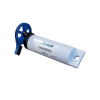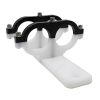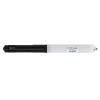PME Cyclops-7 Logger
The PME Cyclops-7 Logger logs data outputted from one Turner Designs Cyclops-7 sensor (sold separately). The PME Cyclops-7 may be connected to a standard USB cable for calibration and storing data.
Features
- Records sensor measurement, time, date, logger battery voltage and gain
- Sampling rates can be adjusted by the user, with a minimum time interval of 5 seconds
- Data are offloaded from the logger to a computer via a standard USB cable
- Expedited repair and warranty service
- Lifetime technical support
- More
Overview
The PME Cyclops-7 Logger is a self-contained data logging package for unattended monitoring. The Cyclops-7 Logger software allows the user to conduct sensor calibration as well as create visual plots of the data collected. The software is easily installed and operated.
Durable
The outer case of the Cyclops-7 Logger is constructed from Delrin, a hard and durable plastic material that does not easily crack or break. All internal circuitry and sensor components have been specifically designed to fit on the logger's spine. The batteries, SD card, on/off switch, circuit board, and other components are attached to a chem film aluminum spine.
Pairable Sensors
- Blue Green Algae
- CDOM/FDOM
- Chlorophyll
- Crude Oil
- Fluorescein Dye
- Optical Brighteners
- Refined Fuels
- Rhodamine WT Dye
- Tryptophan
- Turbidity
In The News
Stone Lab: Cyanobacteria Monitoring in Ohio Lakes
Microcystin, one of several toxins produced by the cyanobacteria that form harmful algal blooms (HABs), has become a popular topic of lake research as the human health impacts of HABs become better understood. Stone Lab is one of the leading groups in algal bloom research on Lake Erie and other lakes in Ohio. For more than 100 years, Stone Lab has conducted biology research and provided science education and outreach to the region. Over the years, thousands of individuals of varying ages have learned from the resources Stone Lab provides. Stone Lab’s Research Coordinator and Senior Researcher, Justin Chaffin, learned of Stone Lab while an undergraduate student at Bowling Green State University Fireland Campus.
Read MoreFrom Assessment to Angler: Continual Research Ensures Lake Erie Remains a Beacon of Freshwater Fishing
Lake Erie is well known for its abundant recreational fishing. Anglers come from across the country to try their luck at the “walleye capital of the world” and search for other freshwater species, such as bass, perch, and steelhead trout. As one of the world’s largest freshwater fisheries, much effort is made behind the scenes to maintain fishing opportunities for visitors to enjoy year after year, efforts that often go unnoticed by the public. One of the lake's most important economic and tourism centers is the city of Sandusky, home to the Sandusky Fisheries Research Station . As part of the Ohio Division of Wildlife, the unit serves as a base for assessing fish populations and managing harvest with partner agencies from around Lake Erie.
Read MoreHigh Definition Stream Surveys: Informed Management in Local Waterways
When it comes to environmental monitoring, new stream survey methodologies have revealed a great deal about water quality and streambed conditions over time. Such information can be particularly important in leading restoration initiatives and prioritizing management decisions. Historically, stream surveys have been conducted at a single point along the stream, with data then extrapolated for miles up and downstream. However, Brett Connell, Hydrologist and Director of Sales at Trutta Environmental Solutions, started developing a more intensive stream survey format in his master's program in 2010 at the University of Tennessee.
Read More

























